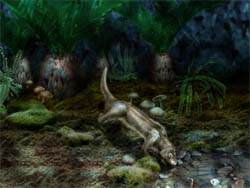
An artist's representation shows a newly discovered mammal species living 125 million years ago in north China. (Credit: Nicolle Rager Fuller)
When farmers from north China's Hebei Province showed a research team led by CAS paleontologist CHEN Peiji a peculiar stone slab they had happened to unearth one day in 2001, they might not realize it would be an important discovery in paleontology.
Six years later, a Sino-US research consortium reveals that it is a new species of mammal that lived 125 million years ago during the Mesozoic Era.
As reported in the 15 March issue of
Nature, the new mammal offers first-hand evidence of early evolution of the mammalian middle ear - one of the most important features for all modern mammals.
Named
Yanoconodon allini after then Yanshan Mountains in Hebei, the fossil was unearthed in the fossil-rich beds of the Yixian formation and is the first Mesozoic mammal recovered from Hebei, about 300 kilometers outside of Beijing. It also refers to Dr. Edgar Allin's studies on mammalian ear evolution. Yanocono corroborates the hypothetical model of an intermediate evolutionary stage proposed by him in 1975, says CHEN Beiji, a co-author of the Nature paper from the CAS Nanjing Institute of Geology and Paleontology.
The researchers discovered that the skull of
Yanoconodon revealed a middle ear structure that is an intermediate step between those of modern mammals and those of cousins, also know as mammaliaform.
"This new fossil offers a rare insight in the evolutionary origin of the mammalian ear structure," notes Zhe-Xi Luo, correspondent author of the article and a paleontologist with both the Carnegie Museum of Natural History and Nanjing University. "Evolution of the ear is important for understanding the origins of key mammalian adoptions."
Mammals have highly sensitive hearing, far better than the hearing capacity of all other vertebrates, scientists have found. Consequently, paleontologists and evolutionary biologists have been searching for more than a century for clues to the evolutionary origins of mammal ear structure.
Mammalian hearing adaptation is made possible by a sophisticated middle ear of three tiny bones, known as the hammer (malleus), the anvil (incus) and the stirrup (stapes), plus a bony ring for the eardrum (tympanic membrane).
The mammal middle ear bones evolved from the bones of the jaw hinge in their reptilian relatives. However, paleontologists long have attempted to understand the evolutionary pathway via which these precursor jaw bones became separated from the jaw and moved into the middle ear of modern mammals.
"Now we have a definitive piece of evidence, in a beautifully preserved fossil split on two rock slabs," said Luo. "
Yanoconodon clearly shows an intermediate condition in the evolutionary process of how modern mammals acquired their middle ear structure."







